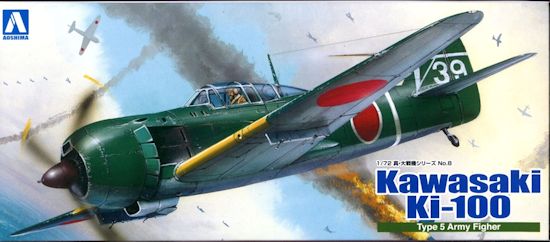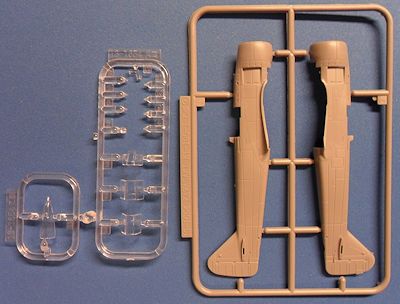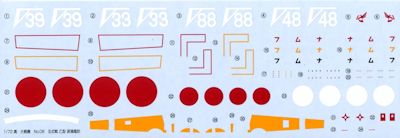
Aoshima 1/72 Ki-100 Otsu
| KIT #: | 008126 |
| PRICE: | 1800 yen |
| DECALS: | Four options |
| REVIEWER: | Ed Bailey |
| NOTES: |

| HISTORY |
Once the Ki-100 had proved a success, Kawasaki got to work on plans to continue production once it ran out of Ki-61-II airframes to convert. Since the new airframe would be built as a Ki-100 from the start, improvements were incorporated, resulting in the Ki-100 Otsu (or Ki-100-Ib). It differed visibly from its predecessor in having an all-round vision canopy, as intended for the Ki-61-III. Since production of this type began in May 1945, only 118 were delivered.
| THE KIT |
 Aoshima has
produced this second version of the Ki-100 by replacing the fuselage halves and
partly replacing the transparent parts. Except for the rear canopy, the two sets
of clear parts are identical, so one mold is used for both, with gates to the
two different rear canopies. These two trees of parts come in one bag, and a
second bag holds the rest of the parts common to both kits. To see the other
sprues, visit the previous preview. Ed The two
versions of the aircraft have identical dimensions, so based in part on my
preview of Aoshima’s Ki-100 Kō, I’d say this kit also has the wingspan exactly
right with an accurate planform, and the assembled length may be short by as
much as 1/16”. The outline of the fuselage and tail also look exactly right
compared to photos and drawings. Like the other kit, it’s molded in light grey
styrene with the high quality of molding you expect from Japanese kits, with
good detail but control surfaces molded in-place. Transparent parts are nice and
clear, with options for open or closed canopy. One common feature I didn’t
remark on in the earlier preview is the opening behind the cowl flaps, which
provides a view of the separately molded exhaust stubs. I plan on thinning the
trailing edge of those flaps, but the parts breakdown in this area will make for
a sharper-looking model.
Aoshima has
produced this second version of the Ki-100 by replacing the fuselage halves and
partly replacing the transparent parts. Except for the rear canopy, the two sets
of clear parts are identical, so one mold is used for both, with gates to the
two different rear canopies. These two trees of parts come in one bag, and a
second bag holds the rest of the parts common to both kits. To see the other
sprues, visit the previous preview. Ed The two
versions of the aircraft have identical dimensions, so based in part on my
preview of Aoshima’s Ki-100 Kō, I’d say this kit also has the wingspan exactly
right with an accurate planform, and the assembled length may be short by as
much as 1/16”. The outline of the fuselage and tail also look exactly right
compared to photos and drawings. Like the other kit, it’s molded in light grey
styrene with the high quality of molding you expect from Japanese kits, with
good detail but control surfaces molded in-place. Transparent parts are nice and
clear, with options for open or closed canopy. One common feature I didn’t
remark on in the earlier preview is the opening behind the cowl flaps, which
provides a view of the separately molded exhaust stubs. I plan on thinning the
trailing edge of those flaps, but the parts breakdown in this area will make for
a sharper-looking model.
Instructions are mainly in Japanese with clear assembly diagrams and the usual
paint color table with numbers for GSI Creos paints (Mr. Color and Aqueous Hobby
Color). Decals are provided for four aircraft of the 5th
Sentai, with only one diagram in the instructions for placement and no
explanation of what markings go with what pilots or units, unless I’m missing it
because it’s in Japanese. White rings aro und
fuselage hinomaru are separate white discs on the decal sheet, leaving it to the
modeler to achieve perfect registration. Printing is nice and sharp and both the
red (A/N16) and deep yellow (A/N20) look right to me.
und
fuselage hinomaru are separate white discs on the decal sheet, leaving it to the
modeler to achieve perfect registration. Printing is nice and sharp and both the
red (A/N16) and deep yellow (A/N20) look right to me.
The box art is a bit crude, like that on similar kits when I was a youngster. Okay, I’m not expecting Shigeo Koike’s fabulous artwork on every aircraft kit coming out of Japan, but I should note the upper color appears to be IJN dark green (N1), which could be a pitfall for modelers unable to decipher the painting instructions. The Ki-100 would have been finished with upper surfaces in Kawasaki’s version of IJA olive-green (A3). The painting instructions in both of Aoshima’s new Ki-100 kits call for Mr Color #130 Dark Green (Kawasaki), a semi-gloss dark olive green. However, neither kit’s painting instructions give any color for the under surfaces or any demarcation line. In a few cases of Japanese aircraft were finished in the upper color overall, but according to the photos and eyewitness testimony I have found, all Ki-100s were finished with a light grey underside, which would have been some version of A/N2, and a very low and straight demarcation line. Bare metal is also possible for the underside, but I haven’t found evidence of it.
| CONCLUSIONS |
For those building a collection of WW2 Japanese
warbirds, Aoshima has provided a bubbletop Ki-100 to be a stablemate to the
razorback, by all appearances providing very accurate kits of both production
versions. For modelers of more obscure subjects, it remains to be seen if
Aoshima produces the Ki-100-II under development at war’s end. By buying
directly from Japan, I got this kit two months before its US release and even
saved a little money.
| REFERENCES |
Francillon, René J.
Japanese Aircraft of the Pacific War, 2nd
edition, Naval Institute Press, 1979.
http://en.wikipedia.org/wiki/Ki-100
January 2014
Thanks to my wallet for this kit and to AmiAmi for discounting the price.
If you would like your product reviewed fairly and fairly quickly, please contact the editor or see other details in the Note to Contributors.